
Texas Symbols
- State Resources
- » 50 States
- » Texas
- » Symbols
Texas State Bluebonnet Festival
The Chappell Hill Bluebonnet Festival

Adopted on June 18, 1997.
The Chappell Hill Bluebonnet Festival, the official Texas Bluebonnet Festival is April 17th and 18th, 2004. The flowers are spectacular and are enjoyed by thousands during the whole month of April. It was adopted on June 18, 1997 when Governor George W. Bush signed House Concurrent Resolution No. 116 on June 19, 1997.
Chappell Hill is located between Houston and Austin, about 65 miles northwest of Houston.
Texas State Bluebonnet Festival:
The Chappell Hill Bluebonnet Festival

The Bluebonnet
Festival offers over 250 arts/craft booths, a food court, children's activities, and entertainment. Past festivals have attracted more than
10,000 visitors over the two day period.
The Bluebonnet Festival is sponsored by the Chappell Hill Historical Society, a non-profit, volunteer organization dedicated to the preservation of
historic buildings in Chappell Hill, Texas. Visit the Museum, Rock Store, the Circulating Library, the Providence Baptist Church, and the Visitor's
Reception Center. The festival area is Main Street, Poplar Street, and the property behind the Providence Baptist Church.
Chappell Hill is situated in the southeast portion of Washington County, which lies Chappell Hill, Texas is located on Hwy. 290, approximately 8
miles East of Brenham, Texas or 65 miles West of Houston. Traffic on Hwy 290 turns North at the traffic light at the intersection of Hwy. 290 and FM
1155.
The town of Chappell Hill was founded in 1847 by Mary Hargrove Haller, granddaughter of Robert Wooding Chappell, for whom she named the town. Mary
Haller's husband, Jacob, was the town's first postmaster. Mary Haller purchased the town site and it was divided into blocks, with streets and alleys
laid off in a regular pattern. The sale of lots began in the fall of 1849.
Situated in the heart of Stephen F. Austin's original colony, the Chappell Hill area had seen earlier efforts at settlement along nearby creeks. In the late 1840s, the town attracted settlers from prominent families of the Old South who were drawn to the fertile land of the Brazos River with its abundant stands of native cedar. The area became an agricultural community with cotton the principal crop.
By the mid-nineteenth century the town gained prominence in the region, boasting sawmills, a railroad line, a Masonic Lodge, five churches, and two institutes of higher learning (the Chappell Hill Female College and Soule University for males founded in 1856).
The Civil War and Reconstruction era brought violent changes to Chappell Hill, as to all the South. But the terrible yellow fever epidemic of 1867 decimated the population to such an extent that the town never fully recovered. Entire families perished, and many others left never to return.
Yet the town has survived and has entered a new era of growth and prosperity, while maintaining its historic charm.
Present-day Chappell Hill is a small village with a colorful history offering visitors year-round hospitality and charm. The town has a delightful combination of restored homes, shops and buildings. Many are found on Main Street, which has been designated as a National Register Historic District.
Renowned for its blooming bluebonnet fields, rolling hills, scenic views, Bluebonnet and Scarecrow Festivals each year, Chappell Hill allows you to step back in time and enjoy a pleasant outing of browsing and strolling along its streets.
Bed and breakfast inns and unique restaurants make it an ideal "get away" any time of year!
Washington County is revered as the home of the "Birthplace of Texas." On March 2, 1836, in the community of Washington-on-the-Brazos, 59 delegates gathered under the direction of Sam Houston and George Childress to draft and sign the Declaration of Texas Independence. Following the receipt of fateful news from the Alamo, these men declared Texas "a free and sovereign nation" and went on to fight at the Battle of San Jacinto. This area is rich with historical sites from the Republic of Texas era.
Chappell Hill Chamber of Commerce
P.O. Box 113 Chappell Hill, Texas 77426
Phone (979) 277-1122
Located 50 miles NW of Houston on Hwy. 290
Texas House Concurrent Resolution No. 116
Texas HOUSE CONCURRENT RESOLUTION H.C.R. No. 116
WHEREAS, In April 1997, thousands of residents and visitors alike will gather in Chappell Hill for one of our state's most popular and colorful yearly
events, the 33rd Annual Chappell Hill Bluebonnet Festival; and
WHEREAS, A much anticipated celebration of spring, the festival honors the spectacular bluebonnets that grace the community of Chappell Hill each April
with their seasonal display of eye-catching blooms; and
WHEREAS, This popular event is sponsored by the Chappell Hill Historical Society, and it began in 1964 as the Bluebonnet Antique Show; the festival
became known by its present name in 1983, and it currently offers fun-filled activities for the entire family, including a hayride through the community's
historic district and abundant opportunities to shop for distinctive wares and furniture from arts, crafts, and antique vendors; and
WHEREAS, The Chappell Hill Bluebonnet Festival will provide a time for many citizens to set aside the cares of daily life and enjoy the flowering
beauty of our Texas spring; this well-loved event continues to be a splendid addition to our state's array of recreational opportunities and is truly
deserving of legislative praise and support; and
WHEREAS, In 1951 the Ennis Garden Club established its first Bluebonnet Trail of Texas, mapping certain locales in the City of Ennis and the area surrounding
the city, thus sharing its bounty of this unique Texas wildflower; these mapped trails have grown to encompass more than 40 miles where the thousands
of visitors may be enthralled for two consecutive weekends in April each year by the spectacular fields of bluebonnets that grow so bountifully in
the area; the City of Ennis has gained renown for having the official Bluebonnet Trail of Texas; an added attraction to those visiting during the weekends
of the Bluebonnet Trail is an antique show and sale that attracts vendors from five neighboring states and benefits the Ennis Heritage Society; now,
therefore, be it
RESOLVED, That Ennis be declared the official Bluebonnet Trail of Texas and that Ennis be designated the Bluebonnet City of Texas because of
the 46 years it has been associated with the official wildflower of Texas and the faithful efforts of the Ennis Garden Club in preserving our state
wildflower for all to enjoy; and, be it further
RESOLVED, That the 75th Legislature of the State of Texas hereby designate the Chappell Hill Bluebonnet Festival as the official Bluebonnet Festival
of Texas and commend all those associated with the event for their hard work in ensuring its success.
House Concurrent Resolution No. 116, 75th Legislature, Regular Session (1997)







